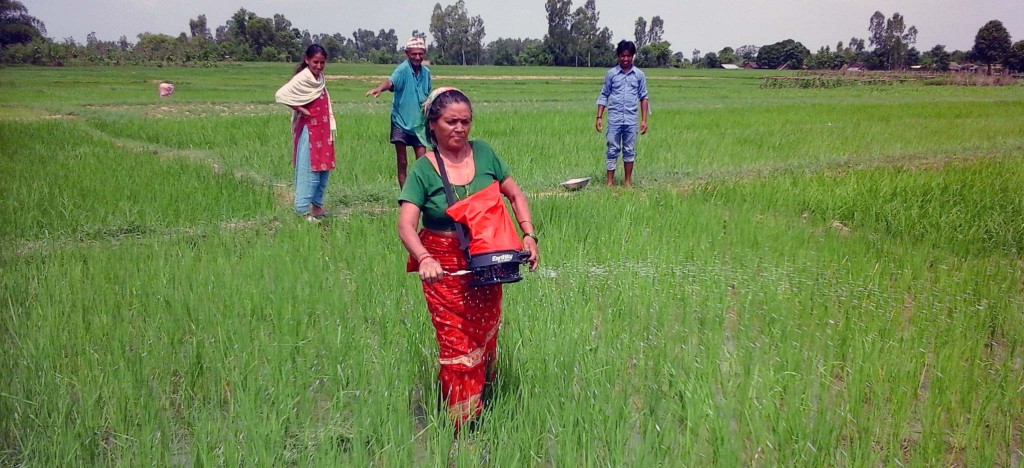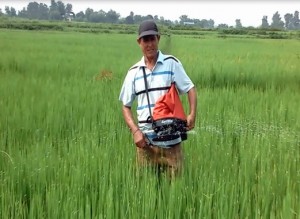Precision Broadcasters: Innovations in Fertilizer Application

Purna Bahadur Sahi, 42, lives and farms in Neulapur, Bardiya district. Sahi used to practice conventional techniques in his fields, which generally did not involve chemical fertilizers. One day, he visited CSISA’s wheat plots in Sirkoiya during a farmers’ field day. During the visit, he came to know that soil needs balanced fertilizers just like people need food. He also witnessed a demonstration of the precision broadcaster (Earthway Spreader 2750). He was intrigued by the little red bag which had a very simple mechanism and could be used with a little practice. Sahi brought himself a broadcaster from Tharu Agrovet, Bhurigaun.
Sahi says, “Earlier I applied little amount (less than 40 percent of recommended dose) of fertilizers to my wheat. Seeing the wheat fields during the farmers’ field day, I felt I should use recommended dose of fertilizers in my fields too.” CSISA provided Sahi a training regarding the use of the Earthway Spreader and fertilizer dosages for various crops. Sahi then used the precision broadcaster on 13 Bighas (approximately 8.67 hectares) of wheat to broadcast urea. Neighboring farmers were skeptical, but once Sahi was in action, other were intrigued by the spreader, seeing the efficient application of fertilizer. Soon, his neighbors came asking for the bag to use in their own fields.

Purna Bahadur Sahi using the spreader for fertilizer application.
However, it was not easy for some of his neighbors. Some had fertilizer landing on their feet and some had accidentally broadcast their fertilizer outside of their field boundary. Sahi decided to teach them the proper way to use it, which he learned from CSISA. Sahi says, “They did not know the proper balance between walking and cranking speed, resulting in loss of valuable fertilizer. Some went all the way to the end of the field, which spread fertilizers 3 meters outside the field. After learning the right technique, they were doing fine. ”
Sahi says that the zipper on top of the bag does not let the fertilizer spill out, or let water in. He adds, “Urea is evenly spread in the fields and crop establishment is even. The spreader applies urea 4 meters on both sides and I don’t have to reach the end of the field boundary to apply fertilizer.”
“It took me 1 hour to fertilize 0.5 Bighas (0.33 hectares) of wheat. I fertilized a total of 13 Bighas (8.67 hectares), which took me approximately 26 hours. I completed the fertilization in a week, working around 3.5 hours per day. In contrast, when I compared with my neighbor who practiced hand broadcasting, he took 66 hours to fertilize the same field (during a different season) at the rate of 2.5 hours for 0.5 Bighas (0.33 hectares),” shares Sahi.
This article is authored by Anil Khadka, Research Associate, CIMMYT.
